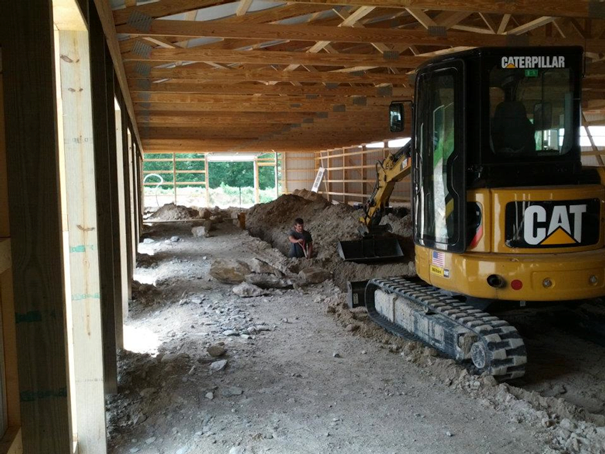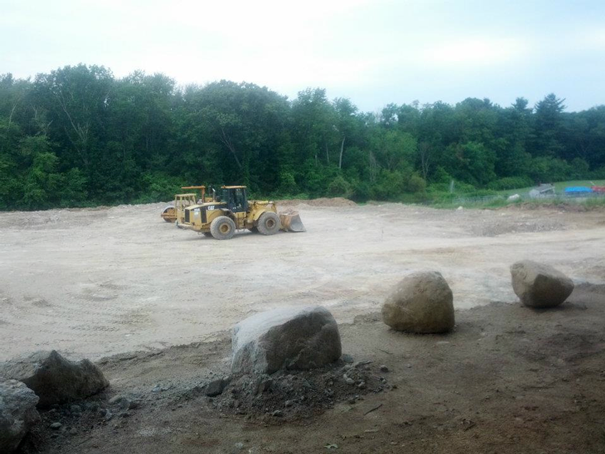10 Things to Know Before Building a Barn or Indoor Riding Arena
Updated December 8, 2022

If you’re preparing to build a new barn or indoor arena, then you’ve got lots of planning to do! Use this list of things to know before getting your building permits and breaking ground to start your farm on the right track:
1. Visit and re-visit to find out your town’s laws

Every town is different, and some are more agricultural-friendly than others. Go to every town department and find out their requirements and by-laws. Towns differ on a lot of topics, including but not limited to:
- buildings set back from property boundaries,
- how much land per horse,
- which departments need to get involved (building, board of health, conservation, zoning, etc.),
- abutter notification, and more
This will help you to be as prepared as possible before construction.
2. Ask local barn owners about their experiences

Talk with someone who has recently built a horse barn and/or indoor in the town. They will have gone through the process and can tell you what difficulties you might run into or if you may be on an easy street. Beware that if it’s for a business (a lesson or boarding facility), they may not be too keen on the idea of helping the competition.
3. Consider engineering costs

If a lot of engineering work is required, realize that you could be spending tens of thousands of dollars for site work and plans. With any luck, it won’t cost that much. However, include that cost in your estimate and budget for it just in case.
Cost will depend on the town requirements, type and size of the buildings, the number of buildings, and the use of the buildings. If zoning does not go through the first time, that could be an extra cost too.
4. Location, location, location

Not just for where your farm is, but also where it’s going on the property. Ask yourself:
- What direction does the sun shine?
- Where are the low-lying, wetter areas?
- Where is the water runoff going to go?
- Which direction does the wind usually blow?
- How much dirt needs to be moved around? Excavators can do amazing things to move dirt around but they can be costly depending on the project.
5. Focus on the farm’s layout

Don’t forget to leave plenty of room for parking, trailer or a large-rig turnaround driveway, horse turn-out, and an area for riding. Get a plot map from the town and sketch out how everything will be laid out. Buy pink/orange flags from your local hardware store and place them where the building edges will be so you can get an idea of just how much space will be taken up.
Think about seasonal changes as well if you live in an area that may get snowfall or heavy rain. When a blizzard is melting, you don’t want the runoff to cause a landslide across your paddocks, or for the snow to block your stall doors. An overhang could help keep your barn accessible through the elements.
Consider which way wind blows from the most when designing so you can work with nature and have the best ventilation possible. Air should be able to flow through stalls and down the aisles. Install as many windows as possible that you can open and close. Your horses will be thankful to have them when the heat index is high! Ceiling fans in the barn or indoor are another option for keeping the horses comfortable.
6. Plan, plan, and plan again

The design for a horse farm will probably change a few times – building size, number of stalls, and the barn’s layout. It’s tough to plan for every possible scenario and you might have some unexpected delays. For example, rocks under the soil could force a whole building to need to be moved over.
If you’re building an indoor riding arena, go for the biggest size possible. If your building is 60’ X 120’ realize that is the measurement of the outside of the building. The arena would only be about 56’ X 116’.
Ask yourself these design questions:
- If you plan to build stalls, where will the water come from for the horses’ water buckets? Do you need to drill a well?
- Will you have hot water?
- Do you want to have a wash stall? How about a birthing stall for mare and foal?
- Where will the manure be stored? What kind of manure management system will you have in place? (Your neighbors will want to know that!)
- How will hay/shavings be unloaded and stored?
- Do you want a warm place to clean tack in the winter? An insulated observation room in the indoor?
- Will you have boarders? And will those boarders need their own locked tack boxes?
- Do you need bathroom facilities?
- What kind of material do you want for the barn aisle floor? Consider if you want to be able to drive a truck through the barn aisle when planning how wide it should be.
- What kind of stall doors would be best? For example, some horses that kick and get antsy around feeding time might not be well suited for dutch doors.
- How can you ensure the building will have good ventilation? Will there be a cross breeze?
- Will there be plugs at each stall for heated buckets/fans?
- Where will the farrier and veterinarian work when there? Will they have proper lighting and electrical plugs available to them?
- Where will your indoor’s entry/exit points be? On the sides or in the middle of either long or short sides?
7. Find professionals you can trust and use references

When considering a builder, visit other barns that they have built to see their workmanship. Talk to others who have used those builders to get their take on how things went. Also consider getting a lawyer who specializes in construction (or better yet agricultural construction) to develop a contract.
Don’t skip on consulting an arena footing expert. Their insight and advice could be extremely helpful, especially if you plan on having boarders at your barn.
8. Get a loan for your barn

If you can’t pay for everything out of pocket, find a lender who understands the agricultural business and can see your vision and work with you to get the best loan. Most regular banks shy away from loaning for barns and other “non-residential” buildings.
9. Know that costs will add up

Plan for costs such as kick/side wall wood on an indoor, stall doors, grates, latches, blanket bars, light fixtures, etc. These costs can all add up really fast! You can cut costs by doing it yourself, but that’s not for the faint of heart or those who enjoy their down time. Especially if you’re on a deadline, it could mean working 12-14 hour days to get the job done within budget.
10. Test-run your contractor before committing
Try out, test, or pilot your ideas and different contractors as much as possible in a small scale. For instance, try to get some of the contractors you are thinking of using to use do a small job around your house or farm. This could be a small electrical project or an excavation job. This will give you a good idea of how close they are to their estimate, their workmanship quality, response time, and how easy or difficult it is to work with them.
For more answers to your riding and horse care questions, head to our Horsemanship Library for articles on barn skills and management best practices.
Originally Published July 14, 2013